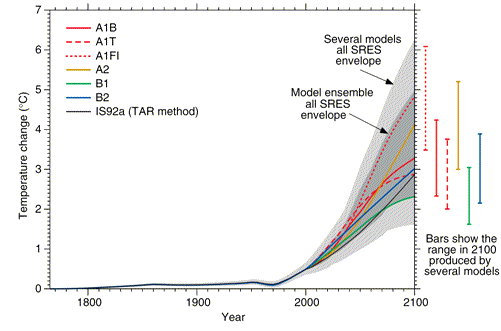|
|
| |
History of Global-Warming Science
|
|
| |
Seventeen thousand years ago, the earth began warming and, in only six thousand
years, completely reversed its 100,000 year trip to the bottom of the last ice
age. During the 11, 000 year warm spell since then, human civilization
developed, and by the 1850s scientists were discovering that their apparently
stable climate had in fact been preceded by an ice age. John Tyndall, an English
scientist, wondered how the climate could have changed so much. He suspected the
atmosphere played a role, as it was known to trap some of the sun’s heat.
Working in his laboratory in 1859, he found that the most important greenhouse
gas was water vapor, but that carbon dioxide (CO2) was also effective
at trapping the sun's heat. .
In 1896, using newer science and a laborious computation, Svante Arrhenius, a
Swede, found that cutting the amount of CO2 in the atmosphere by half
could lower the Earth's temperature some 7–9°F, enough to explain the ice-ages.
His colleague, Arvid Högbom, calculated that in 1896, industry was emitting
CO2 roughly as fast as natural sources and suggested this could
eventually increase global temperatures. Arrhenius then calculated that doubling
the CO2 concentration could raise the
Earth's temperature by about 10°F.
That's a bit on the high side, but not far off considering he calculated with
pencil and paper.
In the 1990’s French and Russian scientists extracted a mile and a half deep ice
core from Antarctica. Analysis by an international team found that over the four
ice-age cycles in the last 400,000 years, CO2 fluctuated nearly in
step with the temperature but by somewhat less than Arrhenius calculated. But
the results puzzle non-scientists because it was found that temperatures started
to rise before CO2 levels increased and started to fall before CO2
levels start to decrease. If this is true, how could CO2 be the
cause of the temperature changes?
The answer is that CO2 did not drive the ice-age cycle. Instead the
cycle was driven by changes in the earth's orbit which caused small temperature
changes. When the earth started to warm, this released CO2 from the
oceans, and that added to the temperature increase. In the ice-age cycle,
CO2 only amplified the temperature swings; it was not the primary
cause. But recently humans, not the oceans, have been releasing
CO2 at an incredible rate by geological standards. Human activity has
become the driving force behind the Earth's temperature changes. However, only
in the last 50 years have greenhouse gas (GHG) emissions accumulated to the
point where they override natural temperature
fluctuations.
In spite of so much progress, there are still puzzles in the scientific
data. This is to be expected since scientists spend as much time looking for new
puzzles as they spend explaining old ones. However, before embarking on
expensive policies, it is important to ask, just what is agreed upon by the
scientific
community.
How big a catastrophe?
It is extremely difficult to put a dollar value on the risk, but a look at
temperature predictions helps make it understandable. The temperature scale on
the graph below is in centigrade, and the average prediction for 2100 is an
increase of about 3°C, or 5.4°F. That's five times greater than the temperature
change so far. There is also a reasonable chance of a 5°C increase in global
average temperature. This is the same temperature change that brought us from
the depths of the last ice age to the present balmy conditions on earth.
Repeating such an increase can be expected to change earth as dramatically. In
this case it would be very likely for some of the more dire possible
consequences of global warming to materialize. For example, a dramatic rise in
sea level would probably become inevitable.

IPCC Working Group 1 TS, p. 50, 2001
|
|
http://zfacts.com/p/908.html | 01/18/12 07:26 GMT
Modified: Thu, 14 Feb 2008 03:37:35 GMT
|
|